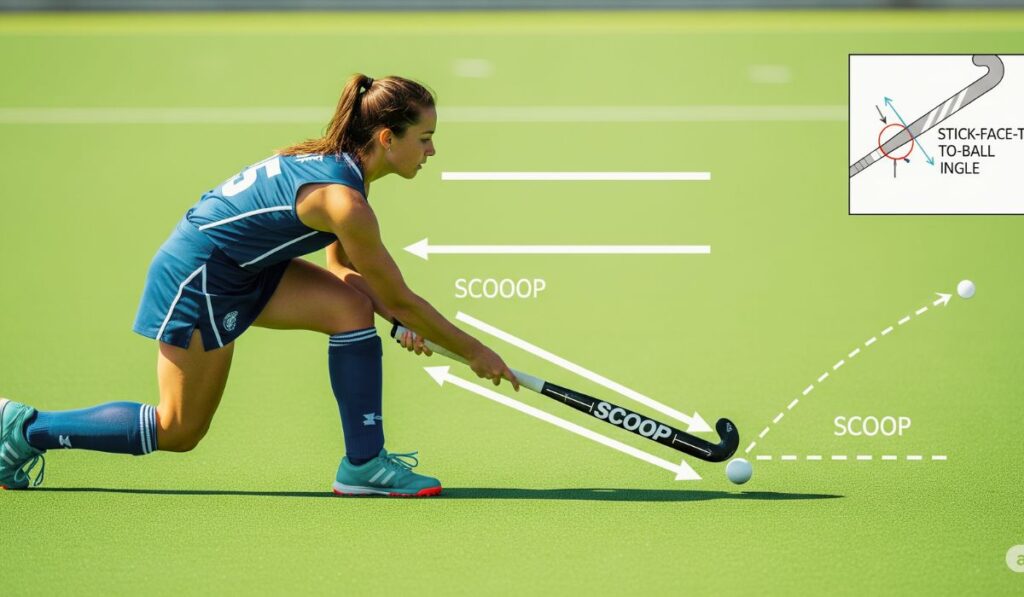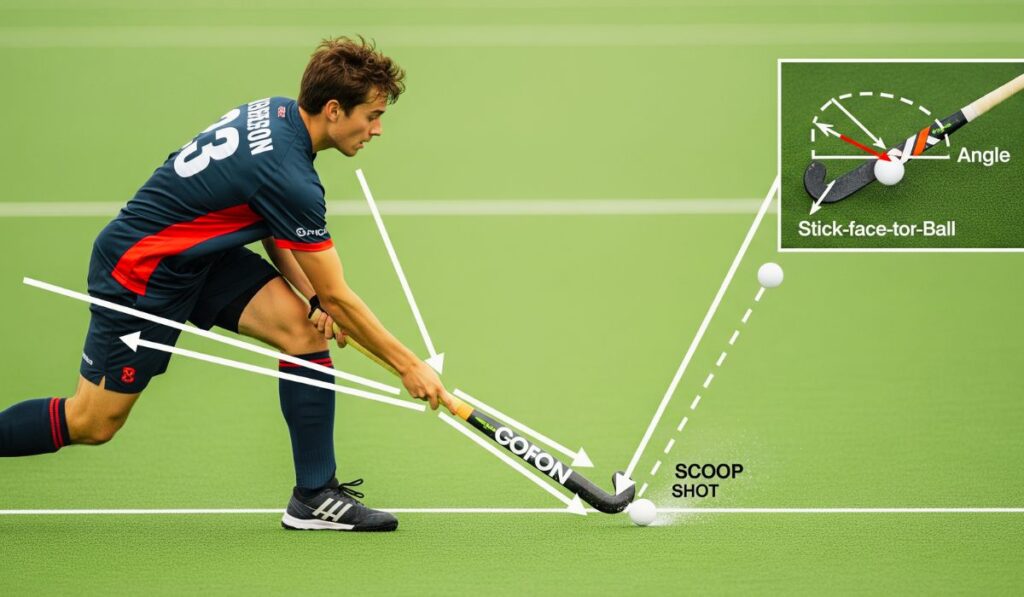“The Scoop in Hockey: From Underrated Trick to Game-Winning Weapon”
Why the Scoop in Hockey Deserves More Attention
When most people talk about hockey, they think of dribbles, hits, and passes. But hidden within the arsenal of techniques lies a move so subtle yet so impactful that it can turn defense into attack within seconds—the scoop in hockey. This isn’t just a technical maneuver; it’s an art, a delicate dance of stick control, wrist strength, and vision on the field. While some players overlook it as unnecessary or outdated, the truth is, mastering the scoop can unlock opportunities that few other techniques can offer.
Imagine being surrounded by opponents, with no clear path forward. Instead of risking a turnover, you glide your stick under the ball, lifting it gracefully over defenders, landing it right into the hands of your teammate. That is the magic of the scoop—a skill that feels almost poetic when done right.
What Exactly is the Scoop in Hockey?
At its core, the scoop in hockey is a lifting technique where the player uses the hockey stick to get under the ball and raise it off the ground. It’s not a reckless hit into the air but a calculated, controlled lift. The ball doesn’t fly chaotically; instead, it arcs in a smooth, floating motion, usually over an opponent’s stick, a defender’s body, or sometimes even an entire wall of players.
Executed correctly, the scoop is like a whispered secret between teammates, invisible to the untrained eye but devastatingly effective against the sharpest defenses. It is both elegant and practical—perfect for bypassing a tight midfield press or launching a quick counterattack.
The History and Evolution of the Scoop in Hockey
The Scoop in hockey wasn’t always as refined as it is today. In the early days of field hockey, when pitches were rough and sticks less flexible, scooping was considered risky. The uneven ground often made it unpredictable, leading players to avoid it. But as hockey evolved—with smoother turfs, lighter balls, and ergonomically crafted sticks—the scoop rose to prominence.
Great hockey nations like India, Pakistan, and the Netherlands began weaving it into their play, using it as both a defensive escape and an attacking weapon. For Indian players especially, the scoop became a signature tool, reflecting their flair, creativity, and ability to turn limitations into opportunities.
Why the Scoop in Hockey is Both Loved and Feared
There’s a strange duality to the Scoop in hockey—it’s admired for its elegance yet feared for its unpredictability. Coaches love it when their team executes it perfectly but frown when it’s attempted without precision. One bad scoop can hand over possession, while one good scoop can win you the match.
For defenders, the scoop is frustrating because it breaks the natural rhythm of ground play. Instead of relying on tackles and interceptions, they suddenly face a ball flying over their heads—something no stick block can stop. For attackers, it’s liberating, a way to break free from suffocating pressure and find breathing space in a crowded game.

The Emotional Beauty of the Scoop
Watch a perfectly timed Scoop in hockey, and you’ll understand why it feels almost poetic. The sound of the stick sliding under the ball, the slow-motion rise of the white sphere into the air, the gasp from the crowd as it clears a defender, and the sweet landing into a teammate’s control—it’s pure artistry.
It’s in moments like these that hockey transcends sport. The scoop becomes more than a move; it becomes a symbol of ingenuity, courage, and vision. It’s the moment when a player dares to break convention, to rise above the ordinary ground game and paint something extraordinary on the canvas of the pitch.
When to Use the Scoop in Hockey
Timing is everything in hockey, and the scoop is no exception. It’s not a move to be spammed; it’s a move to be chosen wisely. Common situations where the scoop shines include:
- Escaping high-pressure defenses.
- Switching play from one flank to another quickly.
- Lifting the ball into attacking positions.
- Clearing the ball safely from the defensive circle.
The key is surprise. A Scoop in hockey loses its charm when opponents expect it. But when used sparingly and smartly, it becomes a dagger through even the most well-organized defense.
The Sensory Experience of Performing a Scoop
For the player, executing a Scoop in hockey is a deeply sensory experience. There’s the feeling of the stick blade sliding under the ball, the controlled wrist flick sending it upward, the quiet flight through the air, and the satisfaction of seeing it land right where you intended.
It’s a skill that requires touch, not brute force. Your palms feel the weight of the ball as it rises; your eyes trace its gentle curve against the sky; your ears tune into the sudden silence before the crowd reacts. Few moves in hockey connect the player so intimately to both the ball and the moment.
Why Neglecting the Scoop is a Mistake
Some players dismiss the scoop as outdated or unnecessary in modern hockey, relying instead on fast ground passes and powerful hits. But ignoring the scoop means losing a vital dimension of the game. Without it, players become predictable, locked into a one-dimensional style that opponents can read and counter easily.
Think of the scoop as your hidden ace. You may not use it every match, but when the need arises, its absence can cost you dearly. Teams that master the scoop often find themselves unlocking spaces that others simply cannot reach.
Scoop in Hockey: A Skill Every Player Must Master
No matter what position you play—forward, midfielder, or defender—the scoop in hockey is a skill worth mastering. For forwards, it means finding pathways to goal. For midfielders, it means breaking tight presses. For defenders, it means safe clearances.
It is versatile, effective, and, when used wisely, unforgettable. In many ways, it separates good players from great ones—the ones who play the game versus the ones who shape it.
Final Thoughts – The Scoop as Hockey’s Forgotten Gem
In the grand orchestra of hockey skills, the scoop often plays in the background. But when the right moment comes, it can become the melody that changes the entire song. It embodies creativity, courage, and control—qualities that define the very spirit of hockey.
So the next time you watch or play, pay attention to the scoop. Notice the elegance in its rise, the suspense in its flight, and the magic in its landing. For within that single arc of the ball lies one of the most powerful yet underrated moves in the game.
The Magic of the Scoop in Hockey
When you hear the phrase scoop in hockey, it may sound simple, almost too ordinary. But anyone who has ever held a hockey stick and tried to lift the ball gracefully into the air knows the profound beauty, the silent thrill, and the deep emotional power behind this technique. The scoop is not merely about execution—it is about freedom. It is about daring to rise above the flat, predictable turf and crafting a play that feels like poetry in motion. When the stick slides under the ball, when the wrists flick with delicate precision, and the ball arcs like a bird cutting through the air, there’s a sense of liberation that cannot be captured by any other movement in the game.
Why the Scoop Matters in Hockey’s Language of Skill
In hockey, every skill has a purpose. Dribbling expresses rhythm. Passing builds connection. Hitting channels power. But the scoop in hockey speaks of artistry and boldness. It carries with it a story of risk and reward. When a player scoops, the entire stadium seems to hold its breath. Will the ball soar cleanly over the opponent’s stick? Will it land in the waiting palms of a teammate’s control? Or will it fall flat, wasted and intercepted? It’s this duality—the promise of brilliance and the threat of failure—that makes the scoop so emotionally captivating.
A Sensory Symphony on the Turf
There’s a very particular sound that accompanies a well-executed scoop in hockey. The stick whispers against the turf, sliding just beneath the ball, and then comes that sweet lift—silent, weightless, as though gravity forgot to pull for a heartbeat. Spectators often describe it as magic, but to the player, it feels like music flowing through the wrists, the arms, the body. You don’t just see the scoop—you feel it in your chest, as the air fills with the suspense of the ball’s flight.
The Emotional Duality of the Scoop
The scoop is both a blessing and a burden for players. It offers a way to bypass defenders, to surprise opponents, to carve open opportunities where none seem to exist. But it also demands exquisite precision. The margin between glory and disaster is razor-thin. Too much force, and the ball sails out of play. Too little, and it dies halfway, becoming easy prey for a defender. This tension—the struggle between control and chaos—infuses every scoop in hockey with an emotional weight few outside the game can understand.
Learning the Scoop: A Journey of Patience and Passion
Young players often underestimate the scoop in hockey. They see professionals execute it and believe it is effortless. But behind that graceful arc lies hours of bruised wrists, frustrated sighs, and endless repetition. Coaches teach players to crouch lower, to angle the stick precisely, to channel not just strength but sensitivity through their hands. The scoop is less about brute force and more about surrendering to technique, trusting that gentleness can sometimes achieve what sheer power cannot.

Scoop as a Form of Expression
In many ways, hockey is a language, and the scoop is one of its most expressive words. Some players scoop with aggression, launching the ball far into the opponent’s half like a bold declaration of dominance. Others scoop with elegance, using the lift merely to glide the ball over a stick and into safer territory. Every scoop tells the story of its player—whether they play with audacity, with grace, with fear, or with freedom. And as with language, it is not always what is said, but how it is said, that leaves its mark.
The Seduction of the Unexpected
One of the reasons the scoop in hockey is so powerful lies in its unpredictability. A defender may expect a hit or a pass, only to find the ball suddenly rising, sailing above their stick, and vanishing behind them. That fleeting helplessness—a defender rooted as the ball arcs beyond reach—is intoxicating for the attacker. For the audience, it is a moment that feels seductive, almost illicit, as if a hidden trick has been revealed before their eyes.
Scoop in Modern Hockey
Modern hockey has changed with technology, strategy, and faster gameplay, but the scoop remains timeless. It has become not just a skill but a tactical weapon. In international tournaments, scoops are used to clear defensive zones, to create fast-break opportunities, and even to unsettle pressing opponents. Watching teams like India, the Netherlands, or Australia employ the scoop is like witnessing choreographed art—a skill woven into the very rhythm of their game.
The Scoop in Penalty Corners and High-Pressure Moments
There is no greater test of composure than performing a scoop under pressure. Picture a penalty corner, where defenders charge forward, sticks clashing, bodies braced for impact. The flick and scoop often decide matches in these tense moments. When the ball rises and slips past the goalie’s outstretched glove, the stadium erupts—not merely because a goal has been scored, but because courage triumphed over fear. That is the emotional power the scoop in hockey carries: it dares to lift the ordinary into the extraordinary.
The Sensory World of a Scoop Gone Wrong
Not every scoop succeeds, and therein lies its beauty. A misjudged scoop creates a hollow thud as the ball bounces awkwardly. Players groan. Coaches bury their faces in their hands. Spectators exhale in frustration. Failure stings more in the scoop than in other skills because it was meant to soar, meant to rise, meant to defy the ground—and instead, it betrayed its promise. Yet even in its failure, the scoop teaches humility, patience, and resilience.


1 thought on “Scoop in hockey”